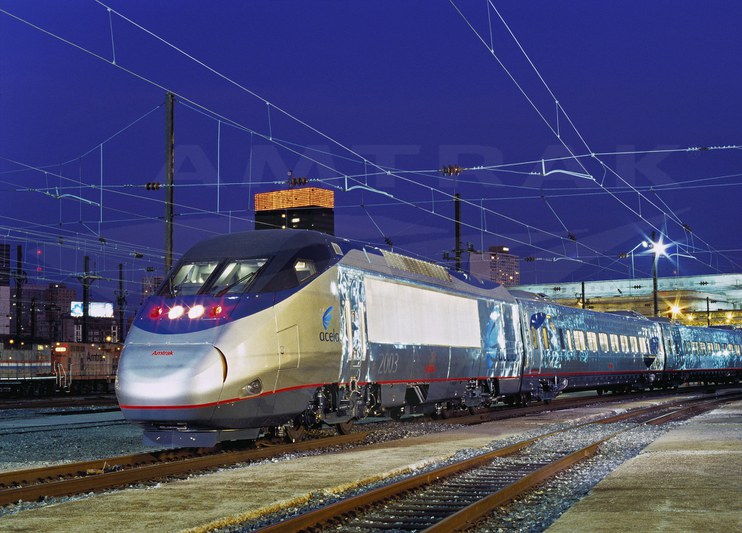My Life With Acela Express (Frosty Memories Included)
CommentsFebruary 11, 2016
A Guest Post by Gary Pancavage
Regularly scheduled Acela Express service began on the Northeast Corridor (NEC) between Washington, New York and Boston on December 11, 2000. Through February, Amtrak is marking the anniversary with special “Acelabrations” for customers and employees. Surprises on the trains, in stations and elsewhere are planned as Amtrak pauses to celebrate this milestone. In a series of blog posts, we’ll take a look back at the journey to Acela Express and explore its future.
Gary Pancavage retired from the Amtrak Mechanical department in June 2015. Prior to his departure, he served as the director of operations for High Speed Rail - Mechanical for more than twelve years. Gary is also an avid railroad photographer, and his work has graced various Amtrak publications including the annual calendar and the employee magazine.
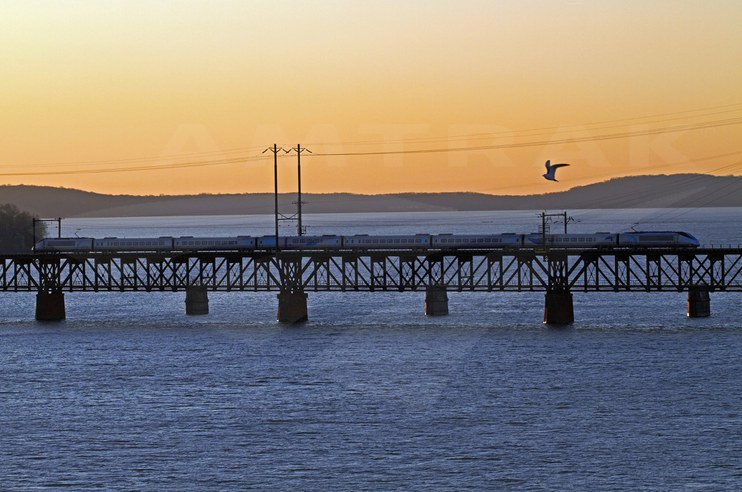
The Acela Express crosses the Susquehanna River in Maryland at sunrise.
As I flipped the page on my calendar today, I can’t believe it is 2016. Another year over and a new one beginning. 2015 was a memorable year on the railroad for me because it proved to be my last. After forty years of diversified service, I greeted retirement with a smile on June 30. The friendships that were forged during my career at Amtrak are forever lasting, but some of the most vivid memories will always be my life with Acela Express during the winter months.
As director of operations for high speed rail in the Mechanical department for more than 12 years, I was tasked with manipulating the 20 Acela trainsets through three maintenance facilities - in Washington, New York and Boston - for inspection and all required repairs necessary for daily operation. This was a daunting task even in good weather.
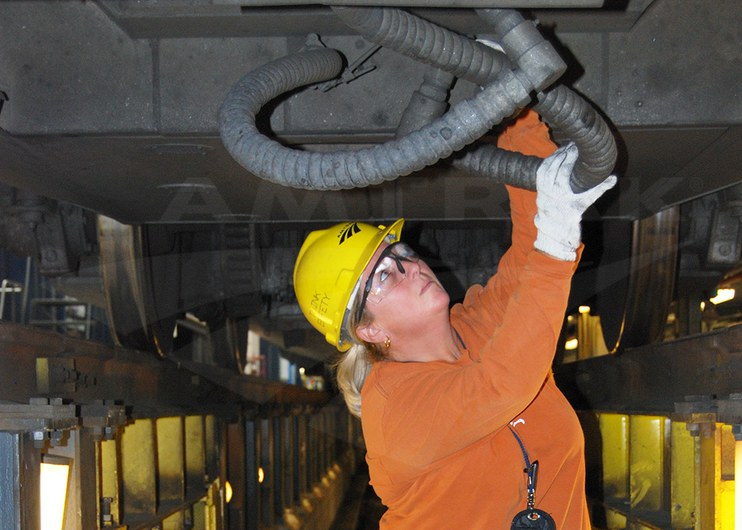
A mechanic examines the underside of an Acela Express
trainset at the Southampton Street Yard in Boston.
Sixteen of the 20 sets were required for weekday service without fail. This left each maintenance facility with one “layover” set to work on with the final set in the fleet assigned to a major overhaul program first at the Penn Coach Yard north of Philadelphia 30th Street Station, and then later at the maintenance facilities in Wilmington and Bear, Del. The margin for recovery was thin when something went wrong unexpectedly, but the resourcefulness of those at the maintenance facilities was nothing short of amazing. Only the direst of circumstances prevented High Speed Rail - Mechanical from making service each day.
Winter with Acela came with its own set of challenges – a completely different story to say the least. Since the five coach cars, café car and two power cars in each set of equipment are designed to operate as a fixed consist, individual bad-ordered cars could not be drilled out separately for repair. Therefore, the entire trainset had to be put in the shops - very frustrating to say the least.
When the snow began to fall, one of the first things we did was to turn off the tilt system, which allows the passenger cars to lean into curves at maximum authorized speed without compromising ride quality (the power cars do not tilt). It didn’t take long for snow and ice to accumulate on the underside of the trainset. Senior management soon decided that the risk of damaging the position sensors wasn’t worth the few extra minutes of schedule time sacrificed by operating Column B speeds that call for slower movement through curves.
Dry, powdered snow presented additional challenges. When these conditions existed, the “full snow plan” was put into effect, taking the trailing power car off line to prevent snow from being sucked inside where it might damage electrical components. Operating with one power car is never a popular choice among train crews because of the additional demand placed on the trainset to get over the road on time, but all involved recognized that it was necessary for the long-term health of the equipment.
Some of the more common things like frozen air lines; partially closed angle cocks, which control the air flow through the friction brake hose connections between cars; and snow-packed horns and bells were dealt with as they occurred while never losing sight of the bigger picture. The days were long, nights even longer, but believe me when I tell you that nobody was happier to see spring arrive than those of us in High Speed Rail - Mechanical.
PHOTOGRAPHING ACELA EXPRESS: ADVICE AND TIPS
If our paths didn’t cross with the operation of Acela, some of you may know me from photographs I have taken depicting daily life on our railroad. I have been asked to share some of my experiences behind the camera with you.
Before we begin to talk about photography, I cannot stress enough the importance of safety. Always be aware of your situation as well as the situation of those around you. Expect a train anytime, anywhere - stay away from the tracks! Also be sure to read the Amtrak Corporate Guidelines on Photography and Video Recording.
Trespassing on private railroad property is not permitted, but luckily plenty of great vantage points exist away from the tracks. Telephoto lenses can place you close to the action while keeping you out of harm’s way. Never become a distraction to railroad employees performing their daily duties, and always inform those nearest to you about what you are doing when taking pictures. Safety is Amtrak’s number one priority and it should be yours as well.
For use in this blog I was asked to pick several of my “most memorable” winter Acela Express pictures and elaborate on what it took to record the image as seen, so here goes.

The image above was taken in early December 2009. Acela trainset number six was assigned to the 2251 run this day out of Boston. Snow was falling at the rate of one inch per hour and the biggest challenge I faced was keeping the lens clean. With camera safely tucked inside of my jacket, I remember calling the Consolidated National Operations Center (CNOC) in Wilmington, Del., to see how the train was running. This was a Saturday and I had weekend duty so photography was secondary. Train No. 2251 was reported on time by GRUNDY Tower in Bristol, Pa., and I took the photo from the Bristol SEPTA station platform with a 200mm telephoto lens. This much snow, this early in the season, was not a good sign of things to come!
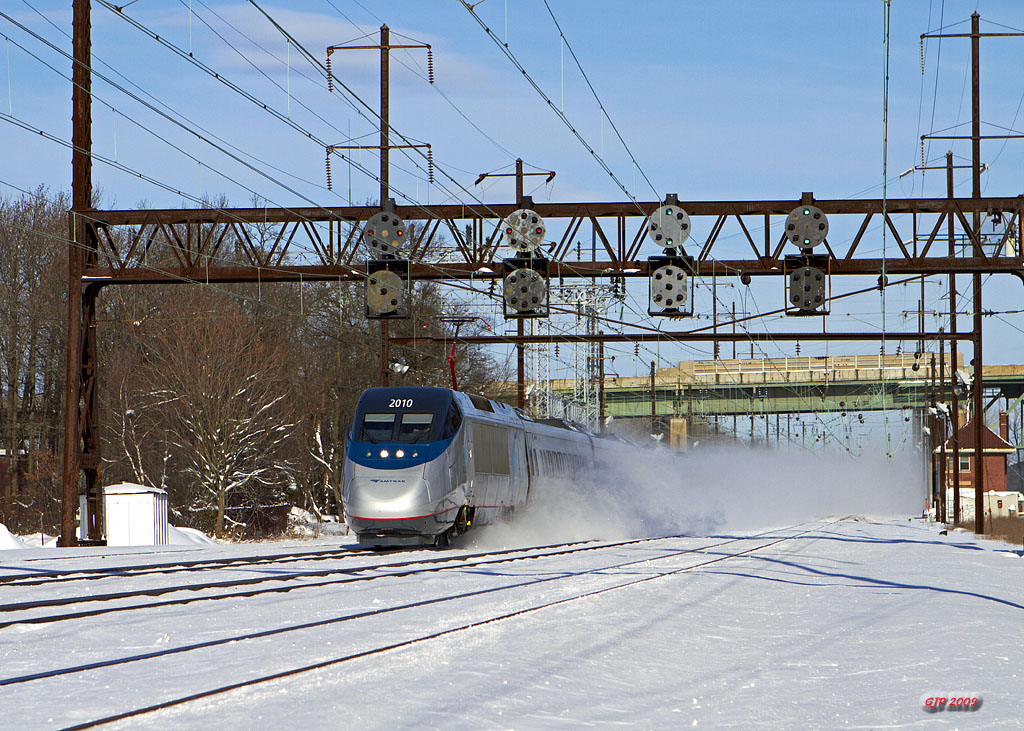
The Acela set shown here was on special assignment this day. It was operating on a cold, crisp Sunday morning as passenger extra No. 883 carrying the New York Giants to Washington for an evening game with the Redskins. This was the first trip out of major overhaul for trainset No. 14. That, plus the knee-deep snow, was reason for me to be present. Way too early to turn the tilt system back on and operating with both power cars was out of the question due to the fine, powdery snow. High Speed Rail Superintendent Michael Doyle was the designated rider to keep set No. 14 moving right along. GRUNDY Tower in Bristol, Pa., is visible on the right.
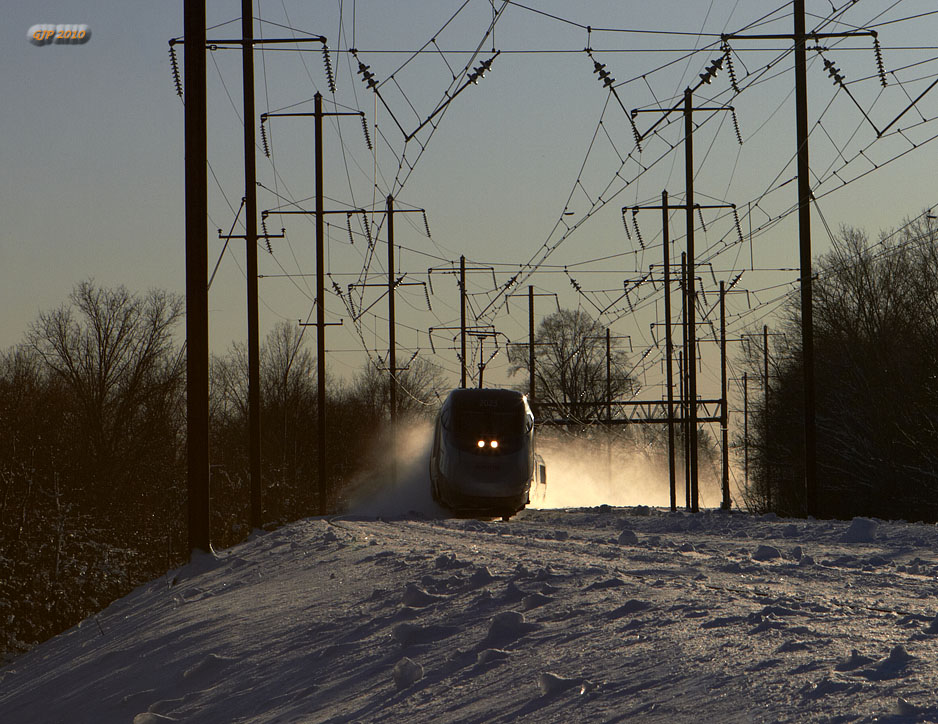
This image defies all conventional logic associated with photography, as I am shooting directly into the sun instead of using it at my back. This is typically done when one desires to create a silhouette effect without including much detail. Remember to set your camera on full manual and use a very small aperture. Auto mode cannot properly compensate in conditions where great differences in contrast exist and an incorrect exposure is sure to result. The train is eastbound No. 2168 rounding the bend at Bristol, Pa.
I am very grateful to the editor for giving me the opportunity to share some of the best experiences I had during my long career. I’ll look for you trackside with camera in hand!




